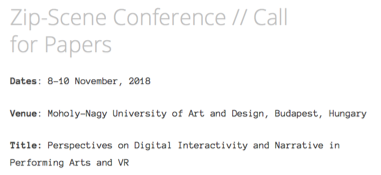ZipScene Conference
ZipScene Conference is for "scientific researchers, game professionals, programmers, artists, scholars and professionals from the field of performing arts, game studies, interactive storytellers, experience designers, VR-professionals and philosophers who are dealing or researching this area."
Dates
8-10 November
Venue
Moholy-Nagy University of Art and Design, Budapest, Hungary
Title
Perspectives on Digital Interactivity and Narrative in Performing Arts and VR
Topic
Game mechanics and other engaging interactive design strategies to raise the level of interactivity in immersive performance art and VR productions
Short description
Digital Interactivity provides novel opportunities for narratives in performance art and VR productions. This means emerging artistic practices, opportunities for critical reflection, and a reconsideration of the roles of the author and the audiences as participants.
One aim of the conference is to investigate whether the format of VR will acquire a status comparable to film, performing arts and video games in the near future. We are planning to explore what kind of storytelling strategies and simulative spaces can be used in such immersive productions, and how much the audience will be able to and would want to engage with control over the narrative path.
Another aim of the conference is to explore how play and game can be interpreted as different types of performances within the genre of mixed-reality theatre and immersive theatre. In both cases, it is also important to focus more closely on how this immersive medium can handle the first person “audience” while co-creating the story with them, and how is this influencing the narrative mechanics.
We are also expecting papers that question the “empathy machine” myth that is mainly related to VR technologies, but which also haunts mixed reality productions. Focusing more on the different tactics and strategies to achieve empathy mechanics is important in order to point out whether the recipient empathizes with the creator of the work, rather than the subjects of the creation, as Fisher states[1]. But it is worth to challenge these strategies by more thoroughly analyzing how to create the sensation of reality and presence in order to engage the users or what kind of mechanics of persuasive game design are these productions using.
Immersion is one of the keywords used in defining new artistic and work environments, which refers to a feature of such environments that can enhance audiences’ perception of being transported somewhere „else”. Transdisciplinary creators are experimenting and making use of playfulness in their works by adapting video game mechanics and narrative design strategies, in order to create fully immersive environments. These environments can be analyzed on several levels: their overall aesthetics, their authorial affordances, from a design perspective, and as a consideration of the audience’s experience, especially, their engaging and empowering mechanisms and last but not least, as interactive narratives. Some possible perspectives (additional ones welcome) include Murray’s affordances and aesthetic qualities of the digital medium[2], Bogost’s procedural rhetoric[3], Kwastek’s “aesthetics of interactivity”[4], multi-sensorial experience atmospheres (based on Gernot Böhme’s concept[5]), the trajectories offered by them (based on Benford-Giannachi’s concept[6]) or as interactive narrative systems (Koenitz, 2015) [7].
It is important and challenging to compare the design strategies of site-specific live arts productions with those of VR works, which also create the experience of full immersivity and presence for their users-turned-participants. For interactive VR-experiences, Jesse Damiani’s taxonomy[8] can serve as a possible interpretation strategy that also applies to forms such augmented reality, virtual reality, and mixed reality.
We are looking forward to receive papers that deal with hermeneutical and phenomenological research as well as pilot studies.
Conference themes
Interactive storytelling methods Interactive videos Video games Location-based technology (with augmented reality) Virtual reality experiences&movies Augmented reality in interactive storytelling Games-based performing arts practices using new technology tools Interactive Museum Immersive environments (media archeology and phenomenological approach)
For whom?
We are addressing this conference to scientific researchers, game professionals, programmers, artists, scholars and professionals from the field of performing arts, game studies, interactive storytellers, experience designers, VR-professionals and philosophers who are dealing or researching this area. The aims and the benefits of the conference is to bring together emerging professionals and creators of these fields in order to create a joint platform which would later help individuals to understand and to develop these types of productions.
LINK
https://zip-scene.com/2018/04/28/zip-scene-conference-call-for-papers/
